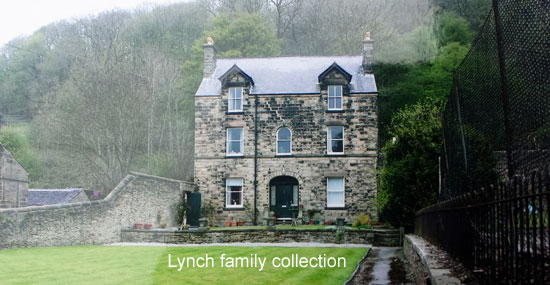|
Images Index> Matlock, 20th and 21stC Images> This page |
| Matlock: Starkholmes, Sheffield Works Societies' Convalescent Home |
| Matlock : Twentieth Century Photographs, Postcards, Engravings & Etchings |
|
|||
The chairman of the Sheffield Works Societies' Association was, in 1914, Mr. Arthur Balfour who was also a master cutler. In a letter to The Times, written from their headquarters in Cutlers' Hall, he explained that when the National Insurance Act (1911) had come into force it was felt that it would destroy the yard and sickness clubs that had been in force in Sheffield for a great number of years. These clubs were managed by the men and their committees was made up of volunteers. Mr. Balfour added that it had been decided to form work societies under the Act, and 33 of the large works in Sheffield had adopted the scheme. In 1914 there were over 10,000 members and the societies were in a good and financially sound position[3]. The sender of the top card was a Mr. Oswald Ward, a Tramway Motor Man who lived in Sheffield with his wife and daughter[4]. He was recuperating at the Convalescent Home. In the image itself are several males. Nearest the gate in the wall is a white bearded gentleman wearing a boater who appears to be reading, another man is standing beside the deck chairs to the left of the front door and on the far right is man standing on a side lawn. At the corner of the house is another man with a young child who is talking to someone sitting in a wheelchair. All the men in the photograph below, or most of them, were also convalescing in Derbyshire having after paid into the scheme. Miss G. Watts, the woman standing behind the third deck chair from the right, was the matron and G. Slack was the secretary[1].
He had lived with Margaret Amelia Skinner, who was one of the Executors of his Will[8]. Miss Skinner was still living at Chindras House in 1911[9] but by the beginning of 1912 Chindras House was advertised as being available to let. It was described as being a suitable for residence for a company house, with about 11 acres of land and modern conveniences[10]. Whilst it is not known quite when the Convalescent Home opened, it can be assumed that it perhaps opened in 1912. By 1919 some 670 patients had benefited from the care provided[11]. It hd an excellent record of restored health. That year saw 186 men admitted, with the total duration of their stay being 500[?] weeks[12a]. In 1921 the Chindras House Home was proving too small for the Association's needs and, as it was going to be too expensive to enlarge[12], the property was offered for sale[13]. The Convalescent Home moved to Stubbin Edge Hall at Ashover, opening there in 1922[12]. Miss Watts, the matron shown in the second image, passed away in 1929[14]. John Joseph Lynch of Hy-Brasail, a retired Customs and Excise Officer, bought the house in 1926[15]. It was divided into at least two flats and in 1939 Francis D Ford, an ARP Warden, and Frances Rose Ford were in one part of the property whilst Sarah A Hardy was in another part[16]. Chindras Cottage was then occupied by James Smith and family[17]. The Lynch family sold the house in 2007[6]; it has been demolished in recent years.
Photographed in 2006, the year before the house
was sold by the Lynch family.
|
|||
|
1. Top image supplied by and Copyright © Ken collection. 2. Second image supplied by and Copyright © Susan Tomlinson collection. 3. 2006 photo © Lynch family collection. Researched, written by and © Ann Andrews. Intended for personal use only. |
|||
References (coloured links are to transcripts elsewhere on this web site): [2] Information from Ken Smith. [3] The Times, Wednesday, 25 Feb, 1914. [4] The card's message was addressed to his wife and daughter. Unfortunately the postmark is unreadable. [5] John Fisher had been baptised at St. Giles' in 1921 and was shown as living at Starkholmes in Kelly's 1891 Directory | Kelly's 1895 Directory | Kelly's 1899 Directory | the 1901 census. He owned land needed when Matlock bridge was widened (see: Matlock: The Bridge (1)). Also see Strays, F. [6] Information from Nick Lynch. A door lintel on the side of the house bore his initials and a date: 'J. F. 1882'. [7] Sheffield Daily Telegraph, 21 June 1904. Obituary. John Fisher of Matlock. [8] London Gazette, 1904. [9] The 1911 census is available on FindMyPast. Miss Skinner had said she was a Householder but the Enumerator crossed this through and substituted Boarding House Keeper. She was also listed in Kelly's 1908 Directory [10] Derby Daily Telegraph, 6 January 1912. To Let notices, under Matlock Bath. [11] "Derbyshire Courier" 4 October 1919. Claremont opened for female workers. [12a] "Sheffield Daily Telegrapht", 30 June 1920. Restoring Workers Health [12] "Sheffield Independent", 21 July 1922. Report of the opening of the new premises. [13] "Sheffield Daily Telegraph", 19 October 1921. [14] "ibid.", 11 January 1929. [15] The Lynch family had lived at Heath Bank in Matlock Dale before moving to Starkholmes. Mr. Lynch passed away in 1944. See a short biography of J. J. Lynch. [15] "Derbyshire Times", 5 March 1932. TO LET at Chindras House, Starkholmes, Matlock - Spacious Fully-appointed Flat, h. and c. with large garden; garage necessary; bus. Mr, Lynch. Hy-Brasail, Starkholmes. [16 From the 1939 register. |







